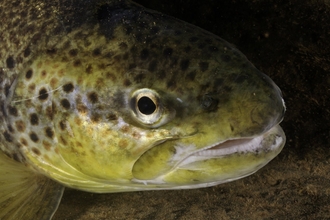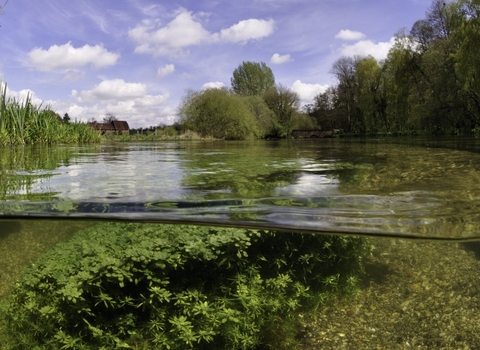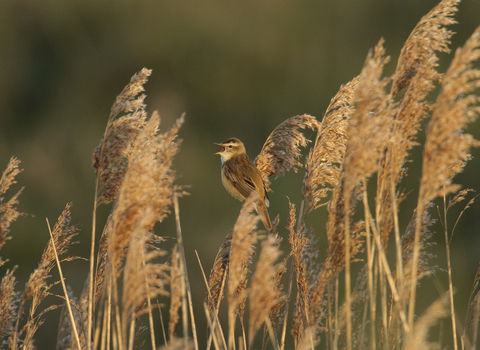
Common reed & sedge warbler (c) Chris Gomersall/2020Vision
Plants
The zonation of plant communities helps us to differentiate between the truly aquatic plants and those plants which tolerate damp soils but no more.
Dry ground supports a different plant community to the seasonally damp hollows of a marsh and from the vigorous, river bed of an upland stream.
A fast, flowing, mountain stream supports a relatively narrow range of plant life, mainly mosses and liverworts, the river bed being too active and the margins frequently scoured clean.
The wetland interest though is considerable in the marshes, flushes, bogs and pools that dominate the uplands each supporting an astonishing variety of plant life.
As a river system continues its journey, conditions change and the associated plant community adapts to take advantage of slower flows or raised nutrients.
There is considerable pleasure in studying life of aquatic plants given the near bewildering variety of habitats they occupy.River Projects Manager, Shropshire Wildlife Trust
River side trees
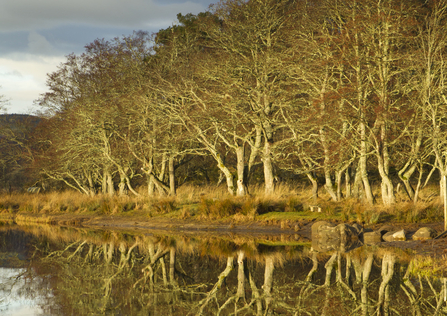
Alder alongside river (Mark Hamblin)
Alders have fiery red, fibrous roots which hang down on the riverbank, swaying loose in the rivers flow. Commonly coppiced for charcoal and nowadays firewood, alders are a fine riverside tree. Sadly in recent years a tree killing fungus has decimated the riparian alders, leaving them as rotten wooden fingers along the bankside. Healthy alders provide water cooling shade, their root systems consolidating crumbling banks and being a native species supporting a host of invertebrates on which chattering birds feed.
Crack willow (c) Brian Eversham
Fast grown willows form the largest group of woody plants which enjoy wet ground and a close proximity to water.
Native crack willows can grow large and heavy, traditionally pollarded along the watercourses of the lowlands, gnarly hosts for countless invertebrates and nesting birds. Cultivated weeping willows grace many an urban park or lake side vista, gently caressing the waters surface in the breeze.
Wet Margins
As water levels rise and fall, from rain or drying, where the banks slope from dry ground to open water, this forms a drawdown zone.
Small plants such as toad rush can happily occupy this zone. Just a little further out in the water is the plants of the margin, a spectacular group of stature and structure. Reedmace hold aloft its characteristic cigar shaped seed-head up to 2 metres above the water. Common reed, a large grass, is taller still and makes the most glorious noise when in number and bent by a pulsing wind. Sturdier but with flashy flowers Yellow flag roots firmly into the sub-surface river bank, occasionally found with the much more delicate firework, flower spike of the flowering rush.
Emergent
As water depth increases some plants are able to root into the river bed and grow upwards to lift their flowers and leaves above the water surface, collecting sunshine and offering a landing for pollinators.
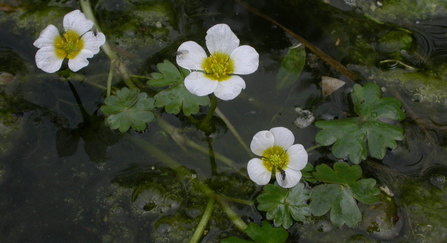
Water crowfoot (c) Philip Precey
Water lilys have thick, sturdy roots systems which grip the river or lake bed, sub-surface leaves being pliable to avoid being broken by water flows. Once on the surface the leaves stiffen, flatten and sit suspended. Water crowfoots have a similar difference between the leaves below the surface and their emergent form.
Many of our native aquatic plants are very rare, the pondweed family with their simple, oval leaves includes a number of species very hard to find. Poor water quality, pollution and inappropriate management have contributed to the decline of many aquatic plants such as Fringed water lily and the rarer pondweeds.
Submerged and floating
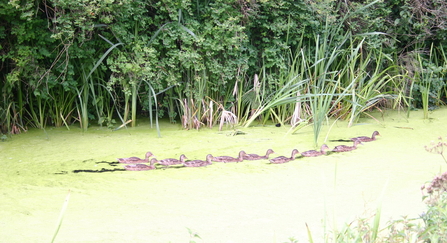
Mallard family in duckweed (c) Jon Dunkelman
Beneath the surface of shallower waters can be glimpsed the dark, whorled leaf stalks of aquatic plants such as Hornwort or Canadian pondweed. These plants have adapted to a full aquatic life cycle. Common duckweed takes a different approach, tiny bouyant leaves float on the surface, root hair hangs down to absorb nutrients.
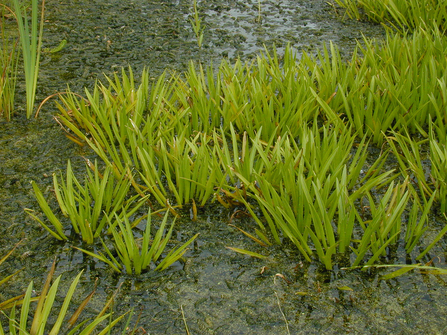
Water-soldier (c) Dr Malcolm Storey
The Water soldier with its rosette of spiky, blade like leaves is not attached to the river or canal bed, spends the winter on the bottom but rises to the surface during the spring to flower. Water soldier in some parts of the UK is a native but has become an unwelcome invasive species in other parts.
Plants under threat
Water pollution, whether chemical or organic, inappropriate management and habitat loss has resulted in the decline of numerous and now rare species.
Read more about water pollution
Over-simplification of our watercourses has removed structural diversity, with meanders and floodplain pools lost to improvement and development. Ponds, lakes and meres have been drained and contaminated by nutrients resulting in delicate ecosystems failing with the loss of plant and animal life.
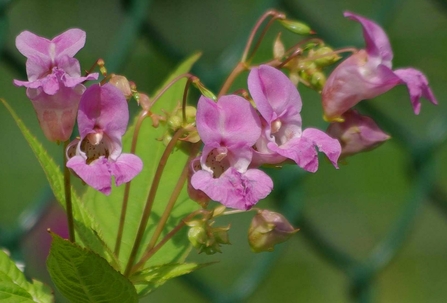
Himalayan Balsam (c) Gillian Day
Into this dynamic and pressured world come a range of non-native aquatic plants such as Floating pennywort or New Zealand stonecrop. Vigorous, spreading and invasive these plants can quickly dominate wetland and open water habitats and pose a very considerable economic and ecological threat. Some such as Skunk cabbage have only limited distributions but Himalayan balsam, a riverside invader, is a river basin scale threat.



